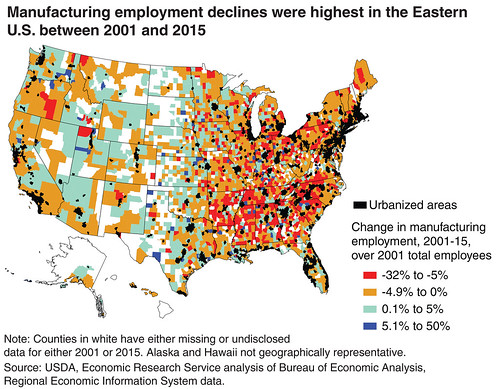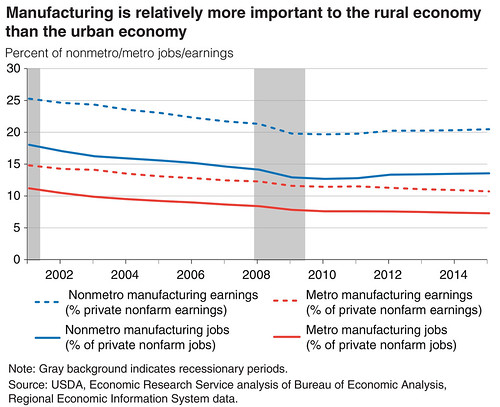
Compared to urban areas, in 2015, manufacturing represented a greater share of both private nonfarm rural jobs (14 percent vs. 7 percent) and rural earnings (21 percent vs. 11 percent). A new report from USDA’s Economic Research Service, Rural Manufacturing at a Glance, examines the manufacturing sector in rural America.
Manufacturing jobs in rural areas totaled about 2.5 million jobs in 2015 and pay relatively well; among all rural sectors, only mining had higher median earnings.
The manufacturing sector’s share of employment and earnings in rural areas began to exceed its share in urban areas in the 1980s, when import competition forced domestic manufacturers to lower costs. Rural areas generally have lower wages, property taxes, and land prices, making these areas relatively attractive to manufacturing firms.
Overall, manufacturing is no longer the driver of job growth that it once was. Between 2001 and 2015, a period that included two recessions (in 2001 and 2007-09), manufacturing employment fell close to 30 percent. In addition, 71 percent of U.S. counties experienced a decline in manufacturing employment. Counties with the largest relative declines were concentrated in the eastern United States, the traditional hub of U.S. manufacturing.
Despite the relative importance of manufacturing to the rural economy, economic restructuring is altering job opportunities for rural areas of the country. Rural manufacturing employment was smaller both in relative and absolute terms in 2015 than in 2001. There were 21 percent fewer manufacturing jobs while total employment grew almost 7 percent. That is, manufacturing employment became a smaller piece of a larger pie.
When a manufacturing plant closes in a community, there is a reduction in local employment, earnings, and government tax revenue. To better understand factors affecting manufacturing plant survival, another ERS study, released in May, followed the plants quarterly from 1996 until the end of 2011, if they survived that long. It found that rural plants have a higher survival rate than urban plants. All else being equal, plants in urban counties were 23 percent less likely to survive than plants in rural counties.
Survival rates were significantly lower for textile and apparel manufacturing industries than other industries. In rural America, textile and apparel manufacturing plants had a 26-percent survival rate between 1996 and 2011. During the same period, rural plants as a whole had a 57-percent survival rate. Trade-related policy changes and automation were two of the reasons for textiles and apparel manufacturing declines during the study period.



